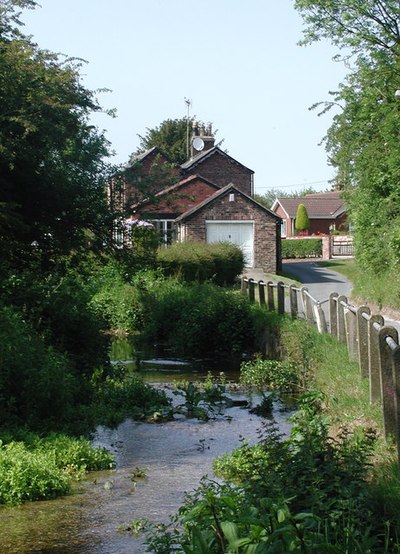Great Wold Valley


The Great Wold Valley is the largest and broadest of the valleys cutting into the Yorkshire Wolds in the East Riding of Yorkshire. Barely noticeable from the map and unmarked, it is a shallow dale through which runs a stream, the Gypsey Race, an intermittent water, which runs from its source near Wharram-le-Street eastwards along and through the northern Yorkshire Wolds to reach the sea at Bridlington.
Within the valley are found a number of ancient scheduled monuments.[1]

There are two dramatic right-angle bends in the course of the Gypsey Race, one turning to the south at Burton Fleming then another turning eastwards again at Rudston. This intermittent and irregular watercourse is believed to be affected by a siphoning action in underground reservoirs and can come into flood apparently regardless of recent rainfall in the local vicinity. This seemingly 'magical' property is speculated to be responsible for the number of significant Neolithic sites along its course, including the Rudston Monolith and the ancient burial mounds at Willy Howe, Duggleby Howe and Wold Newton. Howe, in this case a topographic name from Middle English, originated with the Old Norse word haugr meaning a small hill or a man-made mound or barrow.
Geology
The underlying bedrock of the valley is chalk which was laid down in the Cretaceous period. On the sides of the valley wind blown sand and loess overlie the chalk and in the valley bottom alluvium covers undifferentiated deposits of fragmented chalk which were eroded from the hillsides in the Ice Age. In pre-glacial times the Great Wold Valley was the seaward outlet of the River Ure from Wensleydale but the ice sheets in the Vale of York blocked and then permanently altered the course of the Ure.[1]
Water and wildlife
Watercourses that are intermittent and irregular are locally referred to as 'gypsey springs'. They are found all over the Yorkshire Wolds. The Gypsey Race which passes through the Great Wold Valley is the best known of these watercourses. It is a chalk stream which supports large stands of bur-reed. West of Boynton, Boynton Willow Garth SSSI is an example of fen carr with a mosaic of habitats consisting of fen, scrub, woodland and running water.[2] In the more open areas of the lower valley vegetation includes meadowsweet and great willowherb. Under the woodland canopies wood avens and enchanters nightshade are present.
In the upper part of the valley the Gypsey Race begins at Duggleby Howe. This stretch of the valley is broad and flat bottomed with the valley bottom being around 160 feet above sea level and the sides rising to 500 feet above sea level. In places the stream disappears and land use is mainly arable farming with some areas of grassland. Hedgerows form field boundaries and provide wildlife corridors.
Location
- Location map: 54°8’19"N, 0°23’1"W
Outside links
References
- ↑ Jump up to: 1.0 1.1 Wright, Geoffrey N. (1976). Yorkshire. The East Riding. London: Batsford. ISBN 0-7134-3102-4.
- ↑ SSSI listing and designation for Boynton Willow Garth